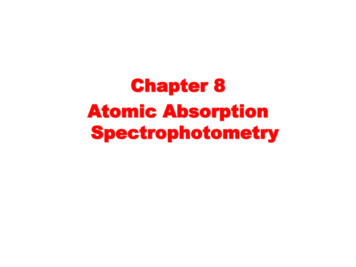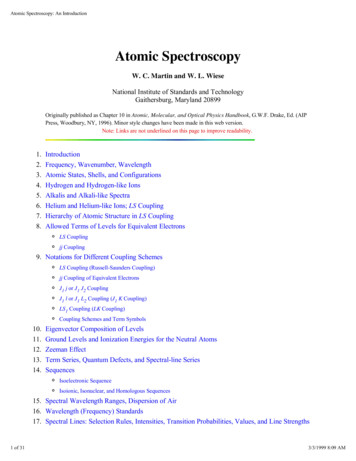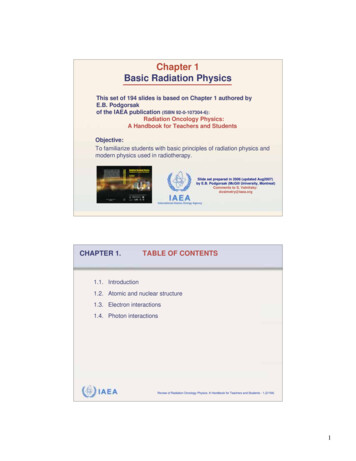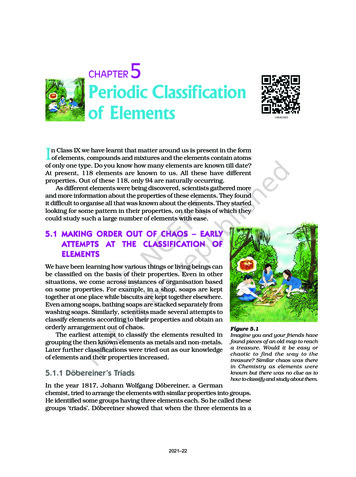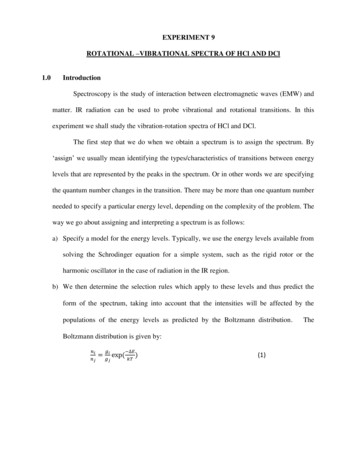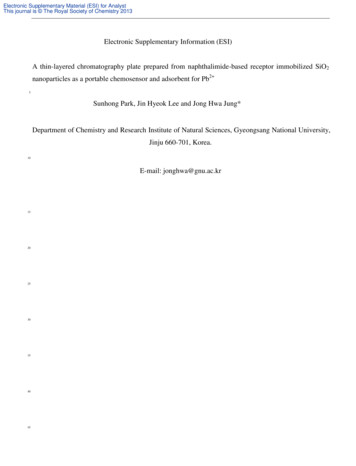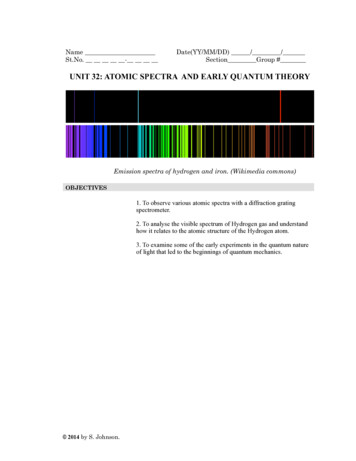
Transcription
NameSt.No. -Date(YY/MM/DD) / /Section Group #UNIT 32: ATOMIC SPECTRA AND EARLY QUANTUM THEORYEmission spectra of hydrogen and iron. (Wikimedia commons)OBJECTIVES1. To observe various atomic spectra with a diffraction gratingspectrometer.2. To analyse the visible spectrum of Hydrogen gas and understandhow it relates to the atomic structure of the Hydrogen atom.3. To examine some of the early experiments in the quantum natureof light that led to the beginnings of quantum mechanics. 2014 by S. Johnson.
Page 32-2Studio Physics Activity GuideSFUSESSION ONE: ATOMIC SPECTRAIncreasing EnergyAn important property of an atom is its characteristic setof energy levels. Each energy level corresponds to one ofthe different configurations of orbital electrons allowed bythe quantum theory of atomic structure. The energy levelsmay be shown on an energy level diagram, such as Fig.32.1 (drawn for a hypothetical atom).E E5E4E3E2E1Figure 32.1: Energy levels in a hypothetical atomThe lowest energy state of an atom is called the groundstate (level E1 in Fig. 32.1). If an atom were totally isolatedfrom any other interactions it would be in its ground state.An atom can be excited to higher energy states, E2, E3,.through collisions with light, electrons or other atoms. Ahigher energy level is the result of one or more electronsgoing to a higher energy orbital around the atom. Onlydefinite, discrete levels are possible, i.e. the energy levelsare “quantized”. In an excited atom, an electron can makea spontaneous transition from a higher energy orbital toone of the lower energy orbitals (See Figure 32.2). Whenthis occurs the atom emits light in the form of a photon (aquantum of light) that has an energy equal to thedifference in energy between the two levels (initial - final) :E(photon) ΔE Ei - Ef(32.1)The frequency of the light f is proportional to the energychange:E(photon) ΔE hfwhere h is a constant known as Planck’s constant. 2014 by S. Johnson.(32.2)
Unit 32 – Atomic Spectra and Early Quantum TheoryAuthor: Sarah JohnsonPage 32-3Figure 32.2: Schematic of atomic absorption and emission of a photon.Because the arrangement of energy levels is unique foreach type of atom, the characteristic set of frequencies oflight emitted by an atom when it undergoes transitions isalso unique and so can be used to identify the atom. Thesecharacteristic sets of frequencies for different atoms areknown as atomic spectra. In this unit we will examineseveral different atomic spectra.For the following activities you will need: Optics Kit spectrometer Post-its from Unit 31 4 spectrum lamps (Hydrogen, Helium, Neon andMercury) 2014 by S. Johnson.Adapted from PHYS 131 Optics lab #4
Page 32-4Studio Physics Activity Guide Activity 32-1: Qualitative Evaluation of Atomic SpectraSFU(a) Four spectrum lamps have been set-up for you to observe withyour diffraction grating spectrometer. (You will have to reconstructthe spectrometer you built in Unit 31. If you’re having a hard timeseeing the spectra with this home-made spectrometer you mayswitch to one of the plastic spectrometers.) The lamps have tubeswhich contain the following gases: Hydrogen, Mercury, Neon andHelium. The lamps have labels A-D. Based on your observationsand comparisons with a chart of known atomic spectra, try toidentify which gas they are. In each case, explain the reasoningbehind your choice.A:B:C:D: 2014 by S. Johnson.
Unit 32 – Atomic Spectra and Early Quantum TheoryAuthor: Sarah JohnsonPage 32-5The Balmer SeriesThe set of frequencies emitted by Hydrogen atoms that fallin the visible part of the electromagnetic spectrum and socan be viewed with our spectrometers are known as theBalmer series. These frequencies results from electronictransitions from higher energy orbitals to the n 2 orbital.In the following activity you will derive a formula that canbe used to calculate the wavelengths of these spectrallines. Activity 32-2: The Balmer Series - Theory(a) According to the Bohr model of the atom, the energy levels forHydrogen are quantized according to the following formula:En (13.6 eV )n2n 1,2,3,.where n is known as the principal quantum number. Using thisformula and Equ. 32.1 write an expression for the energy of thephoton that would be emitted if an electron makes a transition froma level with quantum number ni (initial) to a level with quantumnumber nf (final).(b) Now using your result from part (a) and Equ. 32.2, write anexpression for the frequency of the photon emitted.(c) Now write an expression for the inverse wavelength of thephoton, 1/λ, using the fact that: λf c. 2014 by S. Johnson.Adapted from PHYS 131 Optics lab #4
Page 32-6Studio Physics Activity GuideSFU(d) Plug in the numerical values of Plank’s constant h and the speedof light c given below to arrive at a formula for the inversewavelength that only depends on a numerical constant and the initialand final quantum numbers.h 4.136 · 10-15 eV·sc 3.00 x 108 m/s(e) Hopefully, if all went well, you should have arrived at a formulathat looks like the following: 111 R 2 2 λ n f n i (32.3)where R is known as the Rydberg constant. Write your value for theRydberg constant below and have your instructor check your resultbefore you continue on.The Balmer series spectral lines are due to transitions tothe nf 2 energy level from energy levels with largerquantum numbers so one can use the following formula todetermine the wavelengths of the emitted photons: 111 R 2 2 n 3,4,5,. 2λn (32.4)In the next activity you will compare the predictions of thisformula with the actual wavelengths you observe. 2014 by S. Johnson.
Unit 32 – Atomic Spectra and Early Quantum TheoryAuthor: Sarah JohnsonPage 32-7 Activity 32-3: The Balmer Series - Observation(a) Record the wavelengths for the red, blue and violet lines youobserve in the spectrum of the Hydrogen lamp. (You may need touse one of the plastic spectrometers if you can not see some of thelines with the spectrometer you made.)(b) Using Equ. 32.4, determine the n values for the initial energylevels from which an electron must transition in order to createthese spectral lines. Remember that the quantum numbers must beintegers so you will have to round off your results to the nearestinteger.(c) Use the quantum numbers you found in part (b) and Equ. 32.4 tocalculate the theoretical values for the wavelengths of these spectrallines. Fill in the table below and calculate the percent differencesbetween your observed wavelengths and the theoretical values.λ(obs) 2014 by S. Johnson.λ(theory)%differenceAdapted from PHYS 131 Optics lab #4
Page 32-8Studio Physics Activity GuideSFU Problem Solving Activity 32-4: The Lyman and PaschenSeries(a) The set of spectral lines created when the electron in a Hydrogenatom makes transitions from higher orbitals to the n 1 state iscalled the Lyman series. Determine using Equ. 32.3 what the largestand smallest wavelengths in this series are. What part of theelectromagnetic spectrum (visible, ultraviolet, infrared, etc.) dothese wavelengths fall?(b) The set of spectral lines created when the electron in a Hydrogenatom makes transitions from higher orbitals to the n 3 state iscalled the Paschen series. Determine using Equ. 32.3 what thelargest and smallest wavelengths in this series are. What part of theelectromagnetic spectrum (visible, ultraviolet, infrared, etc.) dothese wavelengths fall? 2014 by S. Johnson.
Unit 32 – Atomic Spectra and Early Quantum TheoryAuthor: Sarah JohnsonPage 32-9SESSION TWO: EARLY QUANTUM THEORYA variety of experiments and observations made duringthe early 1900’s by many different scientists contributed tothe introduction of Quantum Theory. It is now understoodthat Quantum Theory governs the behaviour of systems atvery small length scales. We will examine several of theseearly Quantum Theory experiments.Most physicists consider the beginning of the path toQuantum Theory to be Planck’s quantum hypothesis. In1900 Max Planck proposed a theory that explained theshape of EM radiation curves emitted by ideal radiatingobjects known as blackbodies. An example of the radiationcurves (plots of EM radiation intensity vs wavelength)exhibited by a blackbody at various temperatures is shownin Figure 32.3. Also shown as a dashed line is the curvethat the classical (non-quantum) theory predicts. As can beseen in the figure, the classical theory does not agree withthe experimental data at smaller wavelengths.Figure 32.3: Radiation curves for an ideal blackbody at three differenttemperatures and the curve classical theory predicts for such a radiatingobject.One notable feature of blackbody radiation curves is thatthe maximum intensity occurs at a wavelength, λp, whosevalue varies with temperature. It was foundexperimentally that the product of the peak wavelength,λp, and the temperature in Kelvin is a constant:λpT 2.90 x 10-3 mK(32.5)This relationship is known as Wien’s Law. 2014 by S. Johnson.Adapted from PHYS 131 Optics lab #4
Page 32-10Studio Physics Activity Guide Activity 32-5: Wien’s LawSFUUsing equation 32.5, estimate the peak wavelength for theblackbody radiation from the following. Also state in which regionof the EM spectrum each occurs.(a) ice at 00 C(b) a floodlamp at 3500 K(c) liquid Helium at 4 K(d) the universe at 2.73 K 2014 by S. Johnson.
Unit 32 – Atomic Spectra and Early Quantum TheoryAuthor: Sarah JohnsonPage 32-11Quantized Energy and LightPlanck’s theory encompasses a radical assumption, thatthe energies of atomic oscillations which produceblackbody radiation are quantized. By this we mean thatthe energy cannot have just any value, but that theenergies are multiples of a minimum value E hf suchthat the allowed oscillation energies are:E nhfn 1, 2, 3 .(32.6)where h is a quantity now known as Planck’s constant andhad a value equal to:h 6.626 x 10-34 Jsf is the frequency of oscillation and the integer n is referredto as a quantum number. When a physical quantity is notcontinuous, but rather takes on discrete values i.e. it comesin “steps” then we say that physical quantity isquantized. We might refer to the size of the energy “step”as a quantum of energy.The Photoelectric EffectIn 1905 Albert Einstein took Planck’s idea and extendedit to introduce a new theory of light. He argued that theEM radiation that is emitted by atomic oscillations isemitted in the form of packets or quanta of light. Each 2014 by S. Johnson.Adapted from PHYS 131 Optics lab #4
Page 32-12Studio Physics Activity GuideSFUquantum of light, which we now call a photon, has anenergy equal to:E hf(32.7)where f is the frequency of the light.One experimental phenomena that can only be explainedby using the photon concept of light is the photoelectriceffect. In the photoelectric effect, electrons are emittedfrom the surface of a metal when it is exposed to EMradiation of certain frequencies. (See Figure 32.4 below.)Using his photon model, Einstein predicted therelationship between the energy of the incoming photons,hf, the maximum kinetic energy of the emitted electrons,KEmax, and a quantity known as the work function, W0,which is a measure of the energy required to free anelectron from the surface of the metal. The relationship isas follows:hf KEmax W0(32.8)Figure 32.4: Schematic image of the photoelectric effect where the wigglylines represent photons and the circles containing minus signs areelectrons. Activity 32-6: The Photoelectric EffectIn a photoelectric effect experiment using a sodium surface, themaximum energy of the emitted electrons was measured for anumber of different incident frequencies with the following results: 2014 by S. Johnson.
Unit 32 – Atomic Spectra and Early Quantum TheoryAuthor: Sarah JohnsonPage 32-13Frequency(1014 Hz)Energy ) Plot this data on the graph paper below. 2014 by S. Johnson.Adapted from PHYS 131 Optics lab #4
Page 32-14Studio Physics Activity GuideSFU(b) From your graph determine a value for Planck’s constant.(c) From your graph determine a value for the work function of themetal.(d) Find a value for the cut-off frequency, which is the frequency oflight below which no electrons will be emitted from the surface ofthe metal. 2014 by S. Johnson.
Unit 32 – Atomic Spectra and Early Quantum TheoryAuthor: Sarah JohnsonPage 32-15The Bohr Model of the AtomTo understand the atomic spectra we studied in the firstsection of this Unit, we used the Bohr Model of the atom.Niels Bohr developed this semi-classical model of theatom which incorporated the work of Einstein and Planck.In particular, this model predicts that the energy states ofelectrons within atoms are quantized and that if anelectron changes energy states a photon must either beemitted or absorbed. He called these energy statesstationary states because contrary to classical theorydespite being in orbit the electrons do not radiate EMwaves unless they change states. Bohr’s model is describedin detail in most first-year physics textbooks. We will workthrough some of Bohr’s derivation of this model below. Asyou’ll see, you will be using your knowledge of classicalelectromagnetism and mechanics.Figure 32.5: Classical picture of an electron in orbit of radius r about thenucleus in a Hydrogen-like atom (only one electron). Activity 32-7: The Bohr Model(a) Imagine an electron in a circular orbit of radius r about a nucleuswith a charge of q Ze. Write down an expression for themagnitude of the electrostatic force between the electron and thenucleus. 2014 by S. Johnson.Adapted from PHYS 131 Optics lab #4
Page 32-16Studio Physics Activity GuideSFU(b) Classically this force would produce a centripetal accelerationa v2/r. Using this fact and the value for this force from (a) find anexpression for the radius of the orbit.(c) As you know, the potential energy of a point charge q at adistance r from another point charge q′ can be expressed asPE qV where V kq′/r. Write an expression for the potentialenergy of an electron a distance r from a nucleus with charge Ze.(d) The total energy of the electron can be expressed as a sum of itskinetic energy KE ½mv2 and its potential energy PE. Using thepotential energy you found in (c) write an expression for the totalenergy E of an electron in an atom. 2014 by S. Johnson.
Unit 32 – Atomic Spectra and Early Quantum TheoryAuthor: Sarah JohnsonPage 32-17(e) Now, by solving the expression you found for the radius of theorbit in (b) for mv2 show that the total energy of the electron in anatom is equal to: E –½kZe2/r.(f) This is where the quantum mechanics comes in. Bohr determinedfrom examining the Balmer formula that his theory would agreewith atomic spectra experiments if the only allowed orbits werethose where the angular momentum L of the electron is quantized inunits of h/2π :L mvrn n(h/2π)n 1,2,3 .(32.9)where rn is the radius of the orbit which has quantum number n.Write an expression for v in terms of m, rn, n and h.(g) Plug your expression for v from (f) into the expression you gotfor r in (b) to get an expression for rn. (Remember that both r’s arequantized now.) 2014 by S. Johnson.Adapted from PHYS 131 Optics lab #4
Page 32-18Studio Physics Activity GuideSFU(h) Take your expression for rn from (g) and using the result from(e) write an expression for the quantized energy levels En . Youshould be able to come up with an expression for En that onlycontains physical constants and the quantum number n (no r orv ). Have your instructor check your result before continuing.(i) Now plug in the values for the various constants in yourexpression for the quantized energy and show that the result is:E n (13.6 eV )Z2n2n 1,2,3 (32.10)Show the whole calculation for this including all of the values youplugged in and any unit conversions you did below. Have yourinstructor check your result before moving on. 2014 by S. Johnson.
Unit 32 – Atomic Spectra and Early Quantum TheoryAuthor: Sarah JohnsonPage 32-19One of the biggest successes of Bohr’s model was that itcorrectly predicts the wavelengths of the Balmer lines inthe Hydrogen spectrum which as we saw previously can bedetermined with the following formula: 111 R 2 2 n 3,4,5,. 2λn (32.4)The Bohr model, though not a full quantum mechanicalmodel, can be used to make predictions for Hydrogen-like atomswhere there is only one electron in orbit about thenucleus. The general formula for the wavelength of anemitted photon from a Hydrogen-like atom is: 111 RZ 2 2 2 λn i n f(32.11) Problem Solving Activity 32-8: Using the Bohr Model An ionized helium atom (He ) makes a transition from the n 6(a)state to the n 2 state, emitting a photon. Determine the wavelengthand the energy of this photon. 2014 by S. Johnson.Adapted from PHYS 131 Optics lab #4
Page 32-20Studio Physics Activity GuideSFU(b) Can the photon in (a) be absorbed by hydrogen atoms? If so,between what energy states will the electron in the hydrogen atomjump? Justify your answer. Show all of your work below. 2014 by S. Johnson.
UNIT 32: ATOMIC SPECTRA AND EARLY QUANTUM THEORY Emission spectra of hydrogen and iron. (Wikimedia commons) OBJECTIVES 1. To observe various atomic spectra with a diffraction grating spectrometer. 2. To analyse the visible spectrum of Hydrogen gas and understand how it relates to the atomic structure of the Hydrogen atom. 3.
